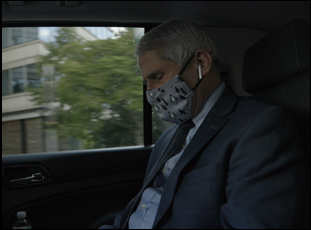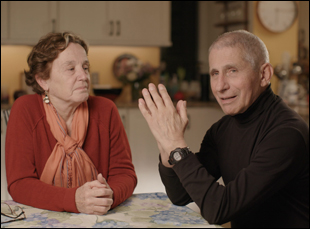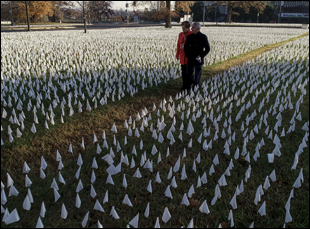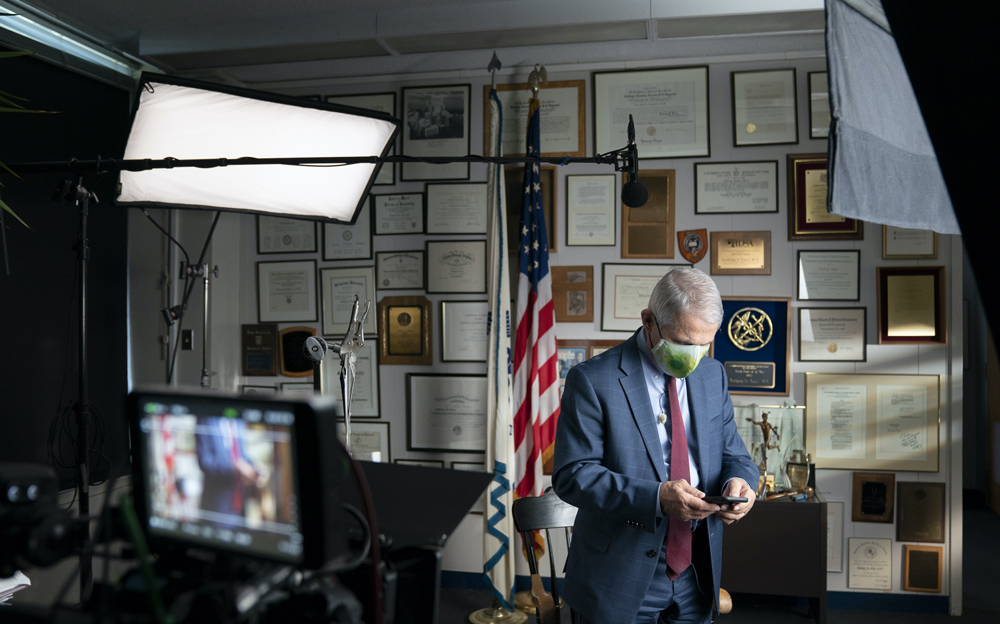In setting her sights on a documentary about the man who had become the point person for the COVID-19 crisis, Janet Tobias joined Dr. Anthony Fauci inside the National Institute of Health just after he was assigned a security detail for the first time in his 40-year career. It was a lonely place quite literally when few others were asked to come in, and as mask mandates and anticipation of a vaccine led to chaos outside the gates, Tobias couldn’t help but imagine her surroundings as a Roman colosseum, in the pit with a great gladiator.
“He was a soldier/public servant that was entering the public forum and people were throwing roses at him and they were also throwing garbage and the level of attention I think was astounding,” says Tobias. “It surprised everyone — the level of the dark web and the attacks — but Tony has a mind boggling ability to stayed focused, so where most of us would be thrown off-base by that level of either praise or criticism or outright hate, Tony has an ability to register it and focus and go back to task and carry on that is extraordinary.”
Before everyone in America knew Dr. Fauci, Tobias had already become well-acquainted, having met the disease specialist during the making of “Unseen Enemy” about the threat of potential viral outbreaks in 2017, and knew of his unshakeable demeanor after seeing it firsthand, so it wasn’t as outlandish as it might seem to ask whether he might want to take part in a biography the two had been discussing in the years since as he worked towards a resolution for the greatest pandemic of our time. “Fauci,” which Tobias co-directed with John Hoffman, not only sees its subject who is at the right place at the right time, both unflappable in the face of intense public scrutiny and already well on his way to developing a defense against COVID with the time invested into mRNA vaccines as a result of his work with AIDS and Ebola, but the filmmakers as well who can put his devotion to serving the greater good into proper context.
While Tobias had come to know Dr. Fauci personally more recently, Hoffman knew of him from documenting the AIDS crisis as it unfolded in New York during the 1980s, and “Fauci” insightfully draws a parallel between the National Institute of Allergy and Infectious Diseases director’s first encounter with a virus of such magnitude without any known cure and approaching COVID-19, building in a respect for the people who contract the disease and fear it as much as for the disease itself, coming to realize that his role isn’t only to tend to antibodies but to calm nerves as well. His no-nonsense approach is shown to have earned the admiration of everyone from former National Security Advisor Susan Rice to former President George W. Bush, both on hand in “Fauci” to testify to his work not only in America but abroad and the film doesn’t only serve as a compelling profile of an unlikely leader thrust into the spotlight but a prescient chronicle of the cyclical nature of public health crises, both in terms of what lessons can be learned to apply in the future and how in spite of what knowledge we have, primal human instincts can often lead to history repeating itself.
Following the film’s premiere at the Telluride Film Festival last month and a limited theatrical run, “Fauci” is being made widely available on Disney+ starting this week and Tobias and Hoffman took the time to talk about pulling off such an impossible project, considering the test of time as they spoke to the man of the hour and getting the film out to the public safely.

Janet Tobias: I think COVID made the collaboration easy because there could only be a tiny, tiny group around Tony initially and I volunteered to go down and that left John, who is the master researcher archivist, working tirelessly through [footage of] Tony Fauci testifying in front of Congress more than any other person [over] seven presidents. Then both of us worked in preparation on the interviews.
John Hoffman: That was really generous of Janet to decamp like that for such a long period of time, and she really up and left New York and entered into a very unusual set of circumstances for filming in the earliest days of the pandemic when we’re all trying to figure out how to not only protect ourselves, but also protect the people that are around us. Thankfully, our industry was able to come up with protocols and the DGA really helped define how to do this safely and Janet and her small team really adhered to that and then [with] a really wonderful team of researchers and associate producers, we built out a 300-page timeline of Tony’s life and that became the foundation for really developing those interviews. We interviewed Tony six times over the course of nine months and it all appears as one interview, but we really broke it down chronologically. We started in his childhood and we moved to the present day over the course of those nine months, so there’s a whole simultaneous effort preparing for those interviews at the same time that Janet was getting the verite material.
Janet, it seems like you might’ve had an inside track on the best practices before the DGA guidelines even came out when your subject is the ultimate source. Did you even need to wait?
Janet Tobias: You’re correct, before the DGA guidelines, we set up our own production guidelines, Story Syndicate and our group and Tony obviously was deeply concerned that he set an example for other people, so as soon as there was any additional evidence, we followed rules adhering to best public health guidelines. I’ve said often we were COVID tested five times a week after testing became a regular practice because it was very, very important that we not expose anyone around Tony to anything, so we were some of the most tested people around.
The film’s opening montage is so dazzling drawing the parallel between the 1980s and now. Was that immediately in mind as a central idea when approaching this?
John Hoffman: We knew that we had a film to bring to the public because Tony’s life has been defined by these two great pandemics of our time, and the elevator pitch was that Tony is a man whose life and career were forged in HIV/AIDS and tested in COVID. That’s how we presented it to National Geographic, so from the beginning, we knew we were going to be comparing and contrasting how he navigated these two pandemics. Something that came relatively early in the editing process was a reference I gave to the editors of a remarkable film called “One Day in September,” about the terrorist attacks in the Munich Olympics [where] the split-screen technique is used to great effect, so it was wonderful to see how that ignited something in the editing process that you see carries through the whole film.
Janet Tobias: And [Fauci] has the same desk he had 40 years ago and he’s an incredibly disciplined human being who gets up and goes to work at the same time every day year after year after year in the same building on the same floor, so we also had this incredible visual parallel of the past and the present because he’s a man of great discipline.

Janet Tobias: I think Tony walks through any health crisis or pandemic with four hats. One, he is a scientist, so he is always thinking what is the scientific solution. In the case of AIDS, it was originally triple therapy or a drug, in the case of COVID, it’s a vaccine. Second, you watch him understand that any epidemic is an epidemic of fear, not just an epidemic of a virus, so he walks through as a communicator and then he walks through as a leader because people are reliant on him as he’s making decisions, but ultimately as he himself says he’s a doctor first, so he always takes all of that – the scientist, the communicator and the leader and thinks about how does that translate to the lives of individuals and families and communities because ultimately he’s a doctor trying to save lives and keep people healthy.
There’s a moment that I’m not sure I want to spoil, but it involves Dr. Fauci tearing up at the sight of some old footage from a speech he gave towards the end of the AIDS crisis. Were you actually taking him down memory lane with old clips throughout?
Janet Tobias: That was unique in the interview. John had planned ahead from wanting to show him that moment. We did show him during the process of verite reference points of Larry Kramer, the activist mentioned in the film, but that speech was such a key moment, and [AIDS activist] Peter Staley’s speech before that that John really wanted him to go back to that moment and of course he did.
John Hoffman: We had no reason to expect that Tony would be as emotional about what he calls “the dark years” of AIDS as he was. We knew that it would be a moving part of the interview, but we didn’t know that he would get caught up and be brought back and feel the pain of that time as much as he did. Having watched countless media appearances by Tony, [I’d] never see him going through an emotional space. He’s always a scientist, always the doctor, always the public health official, so that was a breakthrough in a sense for us as filmmakers.
What’s been interesting in spending time with Peter Staley when we were talking about the film is to listen to Peter say that he had never until understood the amount of caregiving that Tony had done prior to ACT UP’s time with him until seeing the film and that he suffered those losses in the way that he did, so it wasn’t just that Janet and I were surprised by his emotion, it’s that the activists that had become so close to him – these are people who are [now] very good friends and spend a tremendous amount of time together, they had never gone back to that time with Tony. It was not something that pertained to their professional engagements around therapeutics and changing the way that research is done, so that was a surprise to us that this really is maybe the first time that he really has spoken about the pain and suffering that he carries with him.

John Hoffman: We really battled that all the time. There were unfolding events, not only with the science and with the development of the vaccine, but also Tony’s relationship with the White House and his relationship with the task force. There were things happening that got a huge amount of attention and you didn’t know what was going to resonate years to come. There’s 20 hours of interview, so a good amount of it covers the breaking news with him if we had him in the chair at the time because you didn’t know, so you were being expedient, just trying to get as much as you could, not knowing in the edit room what would still be relevant six or nine months later when the film was coming out, but there’s a lot on the editing room floor which is exactly what you’re saying and it was fascinating to experience some of that material losing its value as the editing process went on. Hydroxychloroquine [ended up being] something that plays great importance in the film and that was such a significant moment in the history that it’ll endure historically as a very significant moment in the response to the virus.
Janet Tobias: And I think John’s really right that when you’re there and things unfold politically and even scientifically, you don’t know exactly how important [it is], but one thing I was aware of very early on, not because I’m smart, but because I listened to Tony and his science team is that they believed that they would be successful in making a vaccine. They didn’t know how long it would take, but they understood with the latest technology that they could go fast and there would ultimately be a likely positive result — not as positive as it turned out to be or as successful, but I understood that they had real confidence from the years and years of work they had done before this in actually setting up rapidly responding and developing a vaccine early on because I had the great privilege of being around that group.
And now you’ve actually been able to take the film out into the world. What’s it been like getting this out there?
John Hoffman: It’s exciting. It was challenging in the summer before the Delta Variant really reared its head. We were planning for the release of the film and having to pivot how we all had to pivot because of [how] nature has shown us how powerful evolution is and how quickly it happens in viruses, so we have to adapt. We had this wonderful premiere at the Telluride Film Festival where we were all able to gather safely because of the testing and the vaccines and we were able to put the film in theaters where vaccines and masking were required. But the big opportunity is now, coming out on Disney+ where people can watch it in the safety of their own homes and millions of people will be able to learn about Tony Fauci in a way they don’t know and really come to understand the man that they see when watching the news.
“Fauci” is now streaming on Disney+.




